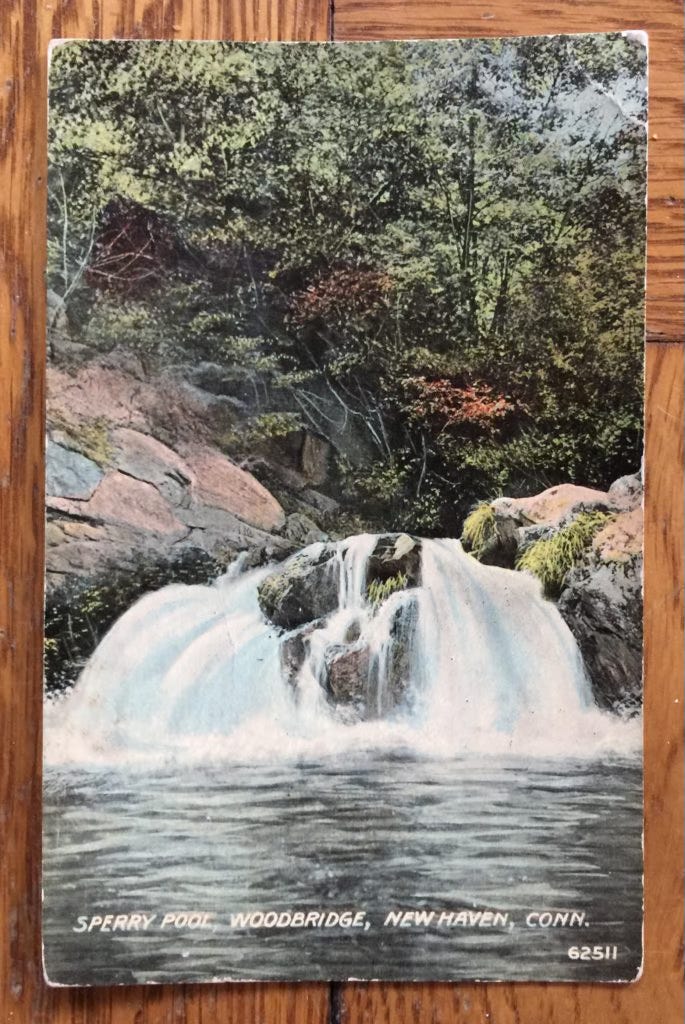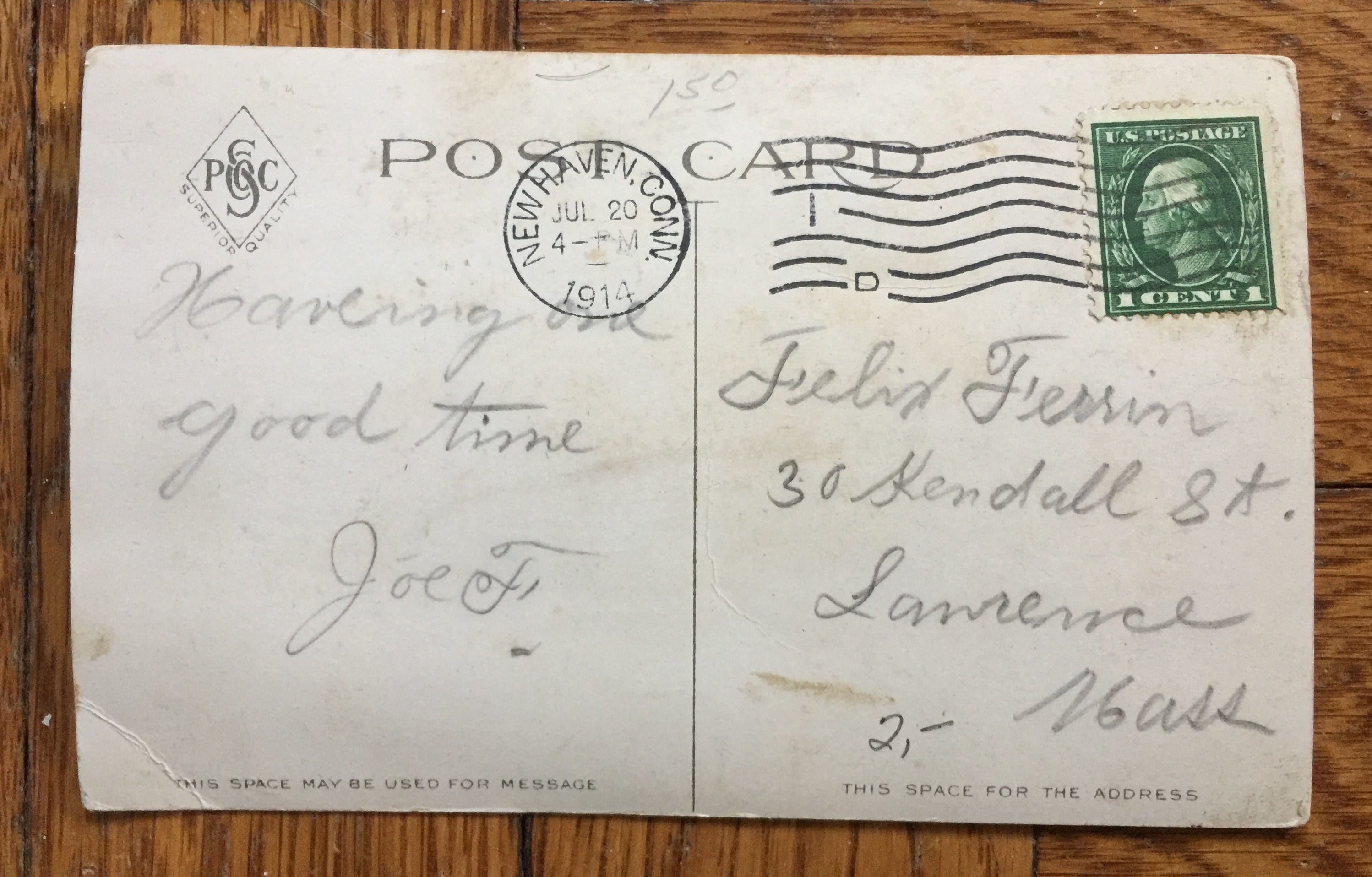A very Sperry visit to Woodbridge in the summer of 1895
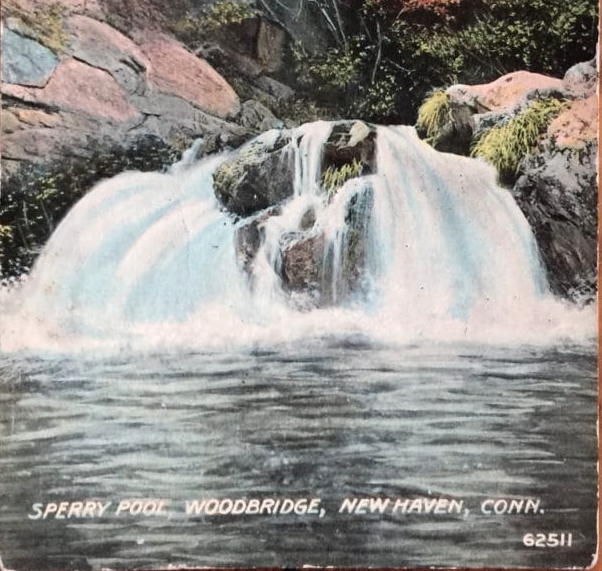
Reading the book Bethany and Its Hills recently, I came across a retelling of another storied visit to Sperry lands in old Woodbridge. The tale is told beginning on page 21 of the book, which can be read online. This account was apparently taken from portions of a news article published in the New Haven Morning Journal and Courier newspaper of July 29th 1895, which is also now available online. For your reading enjoyment, here is the news article text reproduced in its entirety, with some photos I have added to annotate some of what the Honorable Mr. Sperry narrates for posterity:
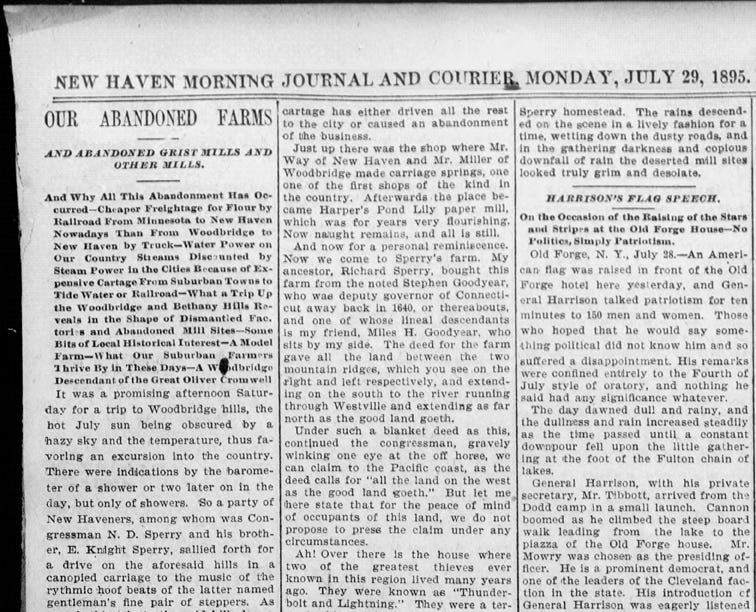
OUR ABANDONED FARMS
AND ABANDONED GRISTMILLS AND OTHER MILLS. And Why All This Abandonment Has Occurred -- Cheaper Freightage for Flour by Railroad From Minnesota to New Haven Nowadays Than From Woodbridge to New Haven by Truck -- Water Power on Our Country Streams Discounted by Steam Power In the Cities Because of Expensive Cartage From Suburban Towns to Tide Water or Railroad -- What a Trip Up the Woodbridge and Bethany Hills Reveals in the Shape of Dismantled Factories and Abandoned Mill Sites -- Some Bits of Local Historical Interest -- A Model Farm -- What Our Suburban Farmers Thrive By in These Days -- A Woodbridge Descendant of the Great Oliver Cromwell It was a promising afternoon Saturday for a trip to Woodbridge hills, the hot July sun being obscured by a hazy sky and the temperature, thus favoring an excursion into the country. There were indications by the barometer of a shower or two later on in the day, but only of showers. So a party of New Haveners, among whom was Congressman N. D. Sperry and his brother, E. Knight Sperry, sallied forth for a drive on the aforesaid hills in a canopied carriage to the music of the rythmic hoof beats of the latter named gentleman’s fine pair of steppers. As usual, this trip to the said hills has a peculiar and tender interest to the excursionists mentioned, as their old home was In Woodbridge. There they were born and reared; there the remains of the old homestead are and every nook and turn in the road, every old house and every new one, every old landmark, the old familiar highways and byways, the lanes and hedges, the copses, the thicket, the stones and running brooks, all have to them a familiar and especial an unfading Interest. Here and there as the ponies trotted musically by with even step, exemplifying the poetry of motion, were passed various abandoned mill sites. And this set the congressman to musing over the subject to which national Interest has been attracted the subject of abandoned New England farms and mill sites. One would think the agricultural glories of New England had all but departed to read the dismal pictures given In the public prints on this subject, the fact that there yet re main many fine and model farms, being temporarily overlooked. Nevertheless there are in many parts of New England just such an array of abandoned mill sites as is to be seen on a trip to the Woodbridge hills. Of abandoned farms, none are to be seen, but of mill sites there are many. But why not unused the congressman. What's to hinder? Why, the reason for the abandoned farms of New England and abandoned mill sites is plain. Just think of it. It is actually cheaper today to bring a barrel of flour by railroad from far off Minnesota to New Haven than it is to cart it from a Woodbridge farm to New Haven. It is cheaper flour freightage from Minnesota to New Haven than it is to cart flour five or ten miles to New Haven from Bethany or Woodbridge. What use then for our grist mills and flouring mills in these towns? Their extinction for commercial purposes was simply a forgone conclusion, when railroad freightage became so cheap in the west and milling accommodations conducted on so vast a scale. This is why the use for these mills which stood along the pretty stream that flows down the ravine to the lovely valley between the big hills that flank the drive to Woodbridge and Bethany came to fall to decay.
![U. S. Congressman Nehemiah Day Sperry [1827-1911]](https://www.townhistory.org/content/images/2024/01/https-3a-2f-2fsubstack-post-media-s3-amazonaws-com-2fpublic-2fimages-2f9b7b9b42-0875-43d7-9b17-4c79ef2e5a4e_202x300-png-1.jpg)
U. S. Congressman Nehemiah Day Sperry [1827-1911]
Then, continued the congressman: As to abandoned farms, what chance had New England farmers to compete when Uncle Sam gives away a farm of 160 acres to every bona fide settler who wants one, a practice which our great and glorious government has been indulging in since 1860 or thereabouts with grand results, as shown in the great increase of national wealth that has resulted therefrom.Here are two abundant reasons to account for the decay of our mills and for the abandoned farms seen in many places in New England. The cost of transporting flour and other grain to market by wagon, especially from Interior towns distant from railroads, has been such In comparison with the low freightage on the railroad that the small farmers had a terribly un equal contest, and have gone to the wall. The same applies to the factories which were once numerous along our country streams, but whose busy hum at the old haunts has ceased forever. These factories, whether run by water power or steam power, had to either give up business or remove their business to the cities to get into proximity with the railroad and save the expense of cartage over the country road.But the farmers in Woodbridge and Bethany and the farmers generally in country towns whose farms are near cities or whose farm products can be readily transported to the cities find a comfortable maintenance in supplying the cities with milk, butter and table vegetables. Fields of waving grain there are, but the product is for home consumption, not for commercial purposes.As the ponies jogged on, the congressman exclaimed: Here was Cox's mill the wheels of which, the old adage said never stood still by night or day. Now all is still there. Next we come to the old Blake mill, where hardware was made. And just ahead was the old mill that William R. Shelton, afterward mayor of New Haven, ran. After him William A. Clark had it, and made bits and augurs. Next Wales French, afterwards chief of police of New Haven, ran it in the same line of business. Now it is occupied by the Beechers for their great match factory industry. But the old mills are gone. And of all the mills whose busy mill wheels were turned by this stream none remain except the Parker mill all either extinct or gone to tide water or to near the railroad. And here let me indulge in a bit of personal recollection. Right there opposite the congregational church was the village school where I taught school many years ago, receiving therefor $47 a month and my board. Ah, there is the Parker mill which does a big business in manufacturing blotting paper, a large amount of which is made for the United States government. It is as I said, the only remaining mill on the stream. The invention of steam and the necessity of cheap cartage has either driven all the rest to the city or caused an abandonment of the business.Just up there was the shop where Mr. Way of New Haven and Mr. Miller of Woodbridge made carriage springs, one one of the first shops of the kind in the country. Afterwards the place became Harper's Pond Lily paper mill, which was for years very nourishing. Now naught remains, and all is still. And now for a personal reminiscence. Now we come to Sperry's farm. My ancestor, Richard Sperry, bought this farm from the noted Stephen Goodyear, who was deputy governor of Connecticut away back in 1640, or thereabouts, and one of whose lineal descendants is my friend, Miles H. Goodyear, who sits by my side. The deed for the farm gave all the land between the two mountain ridges, which you see on the right and left respectively, and extending on the south to the river running through Westville and extending as far north as the good land goeth. Under such a blanket deed as this, continued the congressman, gravely winking one eye at the off horse, we can claim to the Pacific coast, as the deed calls for “all the land on the west as the good land goeth.” But let me here state that for the peace of mind occupants of this land, we do not propose to press the claim under any circumstances. Ah! Over there is the house where two of the greatest thieves ever known in this region lived many years ago. They were known as “Thunderbolt and Lightning.” They were a terror in this vicinity. And here on the left is the lane through which the British red coats marched when in quest of the regicides. and Goffe, Whalley and Dixwell and my ancestor of that period, Richard Sperry, who had many times fed and sheltered the regicides, saw the red coats as they approached, and Goffe, Whallev and Dixwell discreetly fled to the hill which you see over yonder called Providence Hill.
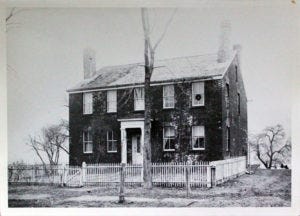
Old Sperry House on Litchfield Turnpike in Woodbridge
That brick house over yonder was built by Albert Sperry, who built the North church, New Haven. Mr. Sperry was an uncle of the late Peck Sperry who was for many years in business on Chapel street, New Haven, firm of Skinner & Sperry. And over there stood the old cooper shop now no more. The shop was run by a man who afterward removed to a place near Syracuse, N.Y., and amassed a large fortune in manufacturing operations there. And by the way, this turnpike we are riding over is the old Litchfield turnpike. It was a great highway once. The malls were carried over this road, and the farmers from up Waterbury way and beyond brought their produce to market in New Haven over this road. They stopped for the night either at Clark's hotel over there or at Darling's a little further on, both of which were very popular hostelries in their day. Now these hotels are no more. The railroads serve the farmers for transportation now if their have anything to transport to a distance. At the old Darling place Mr. Bishop now resides. It is yet a very fine place. A son of Mr. Bishop is of the Bradley, Dann & Carrington Co., right under the “Journal and Courier” office. And here we are opposite the dam. Just over there on the hillside are the ruins of the old cement kiln, where twenty-five years ago they made cement from the rocks that are so abundant around it. It was good cement, but the business failed and was killed because cement was a cheap article and because it took off all the profits to cart the stuff to New Haven. Perhaps some day an electric road will come by here and then the business might be profitably worked. Pardon a personal digression. You see lining the road that fine line of maples and how thrifty they are? Well, a few years ago I came up here and delivered a lecture before the Village Improvement society. One thing I advocated was tree planting and here, through the enterprise of the people, you see the result. Over there was the home of Deacon French. He at one time set type for the “Journal and Courier.” The property is now owned by the New Haven Water company.
![Oliver Cromwell artifact belonging to Anne Wheeler Judge [~1834-1885]](https://www.townhistory.org/content/images/2024/01/https-3a-2f-2fsubstack-post-media-s3-amazonaws-com-2fpublic-2fimages-2f0a113ffe-9949-4436-b71a-d28e713f12ec_350x325-jpeg-1.jpg)
Oliver Cromwell artifact belonging to Anne Wheeler Judge [~1834-1885]
And now let me tell you that over there in that house is a descendant of the great Oliver Cromwell. Her name is Judge, Mrs. Judge, whose husband you see standing near the house. Mr. Judge's wife is a descendant of that great personage, Oliver Cromwell, who made England’s power felt all over the world. And Mrs. Judge has in her house a camp stool that did duty in Cromwell’s army.Near this locality are the foundations of a factory where Mr. Peck, who was the father of the late Lawyer Lucius Peck of New Haven, made iron candlesticks. The place is now no more.Just up there is an old school house under the hill. Once from thirty-five to forty school children were taught there; now the number has dwindled down to seven or eight.Just in that hollow above the lake once stood a grist mill. It was a busy place in its day. It is now no more. It is cheaper to do business in the cities and nigh to the iron horses.Ah! Here we pass the house of friend Doolittle, he of flying machine note. Some day he expects to fly through the air with the greatest of ease on the machine he has been so long at work in his leisure hours. Up there is the house where our esteemed and wealthy townsman, Joel A. Sperry, was born. Up there to the right was once a factory where the grandfather of the late Nelson Hotchkiss of New Haven made hoes and rakes. Now It is all deserted. The company here paused to take a look down the long sweep of valley which lies between the ridges, the view including the splendid new lake of the New Haven Water company, Dawson lake, named in honor of our esteemed deceased townsman, the late Henry S. Dawson. The view in question is certainly very beautiful.
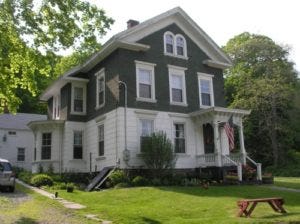
The Samuel Gilbert Davidson House, 539 Litchfield Turnpike in Bethany
And now, concluded Mr. Sperry, we come to a model farm, one of the model farms of Connecticut, that of our friend, Mr. S. G. Davidson, who is one of Bethany's most honored and esteemed men. It is Indeed a model of what thrift, good taste, enterprise, foresight and sagacity well employed can accomplish. With Mr. Davidson in charge, even a wilderness could be made to blossom like the rose. Mr. Sperry and party were the guests of Mr. Davidson and of his estimable wife and son for an hour, after which the homeward journey was begun, and Mr. Knight Sperry's ponies soon brought the travelers home, the homeward journey, though, being by the route which passes the site of the Sperry homestead. The rains descended on the scene In a lively fashion for a time, wetting down the dusty roads, and in the gathering darkness and copious downfall of rain the deserted mill sites looked truly grim and desolate.
A vintage postcard, postmarked in 1914, showing "Sperry Pools" shortly after Nehemiah Sperry and his family donated the Sperry Homelot property to the Town of Woodbridge to create Sperry Park.
